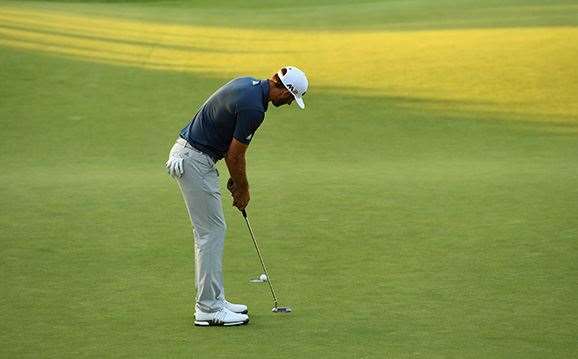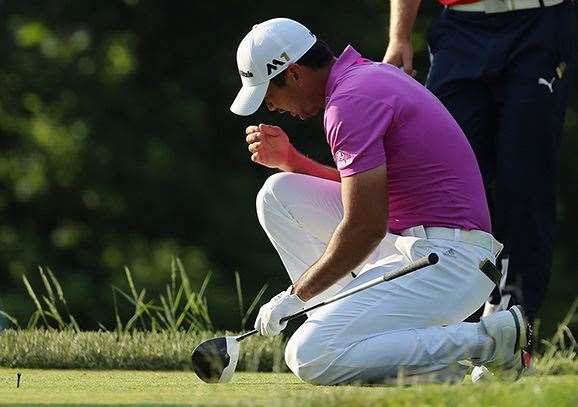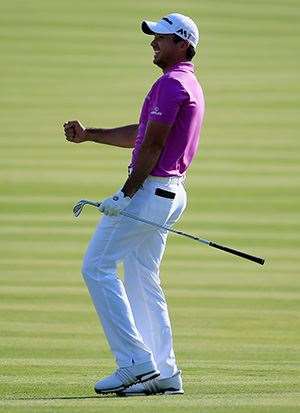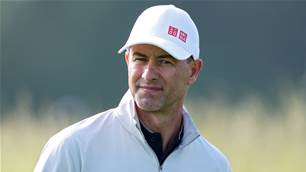Dustin Johnson has buried the demons of missed major wins of past years to capture the 116th US Open Championship in dramatic fashion, reports Mark Hayes.
BY MARK HAYES, GOLF AUSTRALIA, AT OAKMONT CC
Dustin Johnson buried his major championship demons in dramatic fashion today, winning the US Open at Oakmont Country Club despite a rules controversy.
A year after three-putting the final green from 4m to lose the US Open at Chambers Bay, Johnson survived despite having a penalty stroke hanging over his head for the final seven holes.
 Dustin Johnson hoists the US Open trophy high.
Dustin Johnson hoists the US Open trophy high.PHOTO: Ross Kinnaird/Getty Images.
The powerhouse World No.6, who had found himself on the wrong side of rules infractions and late collapses in several previous major championships, was approached on the 12th tee by a USGA official who informed him of an impending review into an incident from which he was exonerated at the time.
In question was whether or not Johnson contributed to a moving ball on the fifth green, the official indicating he could face a one-shot penalty after the round – a ruling later upheld.
At the time he led by two and it clearly rattled his nerves for a few holes as he fell back into a tie.
But the 31-year-old rebounded as others faltered, extending his advantage so far that it didn’t make the ultimate ruling consequential, much, no doubt, to the relief of the USGA.
 Johnson makes birdie on the 18th green to seal the deal.
Johnson makes birdie on the 18th green to seal the deal.PHOTO: Ross Kinnaird/Getty Images.
Adding to the relief for Johnson was the spectacular way in which he finished the tournament – rifling his approach to the 18th inside a metre from where he tapped in his third birdie in what ultimately became a round of 69.
His official four-under total was good for a three-shot win over third-round leader Shane Lowry, who started four shots clear, but imploded late with the putter with a 76 to fall to one under.
Americans Scott Piercy (69) and Jim Furyk (66) joined him as runners-up.
World No.1 Jason Day looked like he might make a late charge to an improbable victory before the penultimate hole scuppered his chances.
Day eagled the 12th and birdied the 13th holes to jump to one under par and suddenly in the mix amid the drama behind.
 Jason Day drops to the ground after his tee shot on the 17th hole finds sand.
Jason Day drops to the ground after his tee shot on the 17th hole finds sand.PHOTO: David Cannon/Getty Images.
But when he found the bunker on the driveable par-four 17th and trickled his second shot into another trap, then left it in that sand for his third, his charge was over.
A double-bogey and a bogey up the last meant a final-round 71 and two-over finish in a tie for eighth.
Adam Scott finished with a flat four-over-74 to be six over, joining Marc Leishman (69) in a tie for 18th position after the Victorian fired a day’s best seven birdies, but also added six bogeys.
Cameron Smith had huge driving issues finding only five fairways en route to an uncharacteristic 79 and a 15-over finish that left him tied for 59th.
FINAL LEADERBOARD | VIDEO: FINAL ROUND HIGHLIGHTS
Johnson had 11 previous top-10 major championship finishes without winning. Among several close calls, he took the lead into the 2010 US Open final round before shooting an 82. He was set to be in a playoff in the 2010 PGA Championship before a two-shot penalty was assessed on the final hole.
And, of course, the three-putt last year from which many thought he mightn’t recover.
And you could tell by the enormous smile on his face that nobody was more relieved than Johnson himself.
“It feels good, it feels really good, it feels really well deserved,” he said.
“I’ve had a lot of opportunities that I didn’t quite get it done, so this one’s definitely really sweet.”
DAY'S RUN GETS BEACHED
Jason Day stood on the 17th tee knowing it was all or nothing.
As it turned out, in a year of “all”, the “nothing” finally had its wicked way with the world No.1.
“I had to push,” Day said after assessing his then three-shot deficit to eventual US Open winner Dustin Johnson.
“You can't win tournaments just laying up there. I had the opportunity to go out there and give myself a shot at winning the tournament.
“I hit a great drive. Unfortunately, it didn't work out.”
Day’s tee shot on the driveable uphill par-4 came within 1m of giving him an eagle try, but hit the top of a cavernous bunker wall and trickled down to its floor.
 Day plays a shot from a bunker on the 17th hole. PHOTO: David Cannon/Getty Images.
Day plays a shot from a bunker on the 17th hole. PHOTO: David Cannon/Getty Images.With the pin tucked in the opposite corner of the treacherous green, Day again went for glory only to see it trickle into a second trap.
Just as he’d done in taking a six on the par-four seventh hole in his costly opening-round 76, he left his next blow in the sand and ultimately signed for the same double-bogey six.
“I had to hit a really good one … because it's a long way up that hill to the front of the green,” he said.
“I hit a great drive. I honestly did. We were aiming just left of the towers and hit it right on my target and kind of sort of kicked right and then down the bottom of the bunker, just a little bit on the down slope.
“It was down-sloped towards (the wall) and you've got to get underneath it with speed and to try and get it high and soft.
“Unfortunately, I just hit it fat and obviously, the rest was history from there.
“It took the wind out of my sails.”
Day had hovered without progressing from his one-over starting point for much of the afternoon.
But a bumped sand wedge for eagle on the long 12th ignited a run that threatened to produce a second major championship.
“I eagled 12, birdied 13, (then on) 14, I just kind of left it out there to the right (with my approach) and made a good two-putt.
 Day celebrates after his birdie putt on the 12th hole drops.
Day celebrates after his birdie putt on the 12th hole drops.PHOTO: Rob Carr/Getty Images.
“(My approach on) 15, if it went five more yards it would have landed on the front and kicked up. That would have given me a good shot at birdie. (It was the) same with 16 – if it went five more yards, it would have caught the top and rolled towards the flag. I hit a great shot there.
“But it is what it is. I've got to understand that these things happen for a reason.
“I've just got to understand that and not be too disappointed, because where I was sitting after my first round, shooting six over par to where I am now, trying to fight my way back in and giving myself an opportunity at winning, especially on a U.S. Open course, it takes a lot of grit and a lot of oomph to get there.
“Unfortunately, I didn't quite make it.”
Australia’s second-ranked player Adam Scott effectively suffered the same fate.
Scott made an early birdie off his two-over starting base, but was still at that mark when he began pushing on the back nine.
But bogeys on 13 and 15 took him from contention and he later said he felt like the double-bogey on the 18th was a closing “kick in the nuts” from a course on which the birdie charges both Queenslanders needed were incredibly difficult to both kickstart and maintain.
Scott ultimately signed for a 74 and a six-over finish to tie for 18th with fellow Australian Marc Leishman.
It was Scott’s fourth top-20 US Open finish in the past five years.
Remarkably, Day’s eighth place was his fifth top-10 in six US Open starts.
Related Articles

The Aussies at The Open

Scott in Oakmont hunt with ‘old-man’ golf













